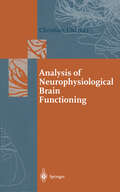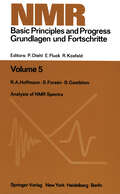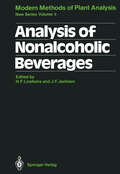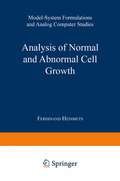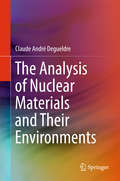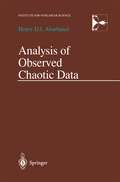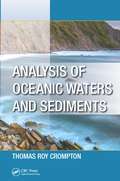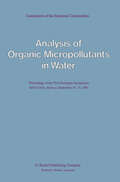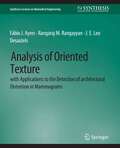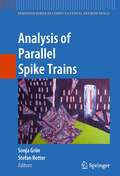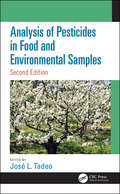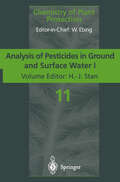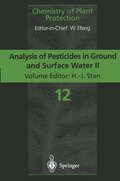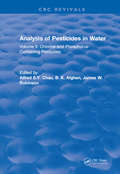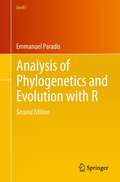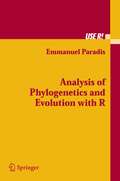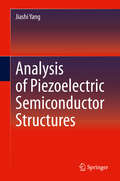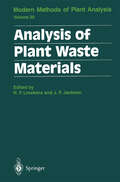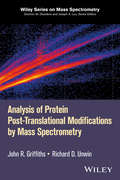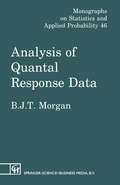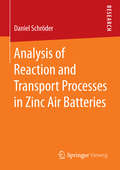- Table View
- List View
Analysis of Neurophysiological Brain Functioning (Springer Series in Synergetics)
by Christian UhlThe analysis of neurophysiological brain function is a highly interdisciplinary field of research. In addition to the traditional areas of psychology and neurobiology, various other scientific disciplines, such as physics, mathematics, computer science, and engineering, are involved. The book reviews a wide spectrum of model-based analyses of neurophysiological brain function. In the first part, physical and physiological models and synergetic concepts are presented. The second part focuses on analysis methods and their applications to EEG/MEG data sets. It reviews methods of source localization, the investigation of synchronization processes, and spatio-temporal modeling based on dynamical systems theory. The book includes contributions by well-known scientists such as Hermann Haken, Scott Kelso and Paul Nunez, among others. It is written for students and scientists from all the above-mentioned fields.
Analysis of NMR Spectra: A Guide for Chemists (NMR Basic Principles and Progress #5)
by R. A. Hoffman S. Forsen B. GestblomNuclear magnetic resonance spectroscopy, which has evolved only within the last 20 years, has become one of the very important tools in chemistry and physics. The literature on its theory and application has grown immensely and a comprehensive and adequate treatment of all branches by one author, or even by several, becomes increasingly difficult. This series is planned to present articles written by experts working in various fields of nuclear magnetic resonance spectroscopy, and will contain review articles as well as progress reports and original work. Its main aim, however, is to fill a gap, existing in literature, by publishing articles written by specialists, which take the reader from the introductory stage to the latest development in the field. The editors are grateful to the authors for the time and effort spent in writing the articles, and for their invaluable cooperation. The Editors Analysis of NMR Spectra A Guide for Chemists R. A. HOFFMAN t S. FORSEN Division of Physical Chemistry, Chemical Center, Lund Institute of Technology, Lund, Sweden B. GESTBLOM Institute of Physics, University of Uppsala, Sweden Contents I. Principles of NMR Spectroscopy 4 1. 1. The Magnetic Resonance Phenomenon 4 a) Nuclear Moments. . . . . . . . 4 b) Magnetic Spin States and Energy Levels 5 c) The Magnetic Resonance Condition. 7 d) The Larmor Precession. . 7 e) Experimental Aspects . . . . 8 1. 2. Chemical Shifts . . . . . . . . 9 a) The Screening Constant 11. . . 9 b) Chemical Shift Scales (11 and r) 10 1. 3. Spin Coupling Constants 12 1. 4. Intensities. . . . . . . .
Analysis of Nonalcoholic Beverages (Molecular Methods of Plant Analysis #8)
by B. Biehl E. Cohen L. W. Doner T. T. Fang P. B. Hutt L. Izquierdo R. L. Johnson P. K. Mahanta I. Saguy P. Schreier K. E. Scott J. M. Sendra T. Shibamoto M. A. Stevens T. Suzuki T. Tsuda P. Vaag L. P. Valenti G. R. Waller G. ZieglederModern Methods of Plant Analysis When the handbook Modern Methods of Plant Analysis was first introduced in 1954 the considerations were: 1. the dependence of scientific progress in biology on the improvement of existing and the introduction of new methods; 2. the difficulty in finding many new analytical methods in specialized journals which are normally not accessible to experimental plant biologists; 3. the fact that in the methods sections of papers the description of methods is frequently so compact, or even sometimes so incomplete that it is difficult to reproduce experiments. These considerations still stand today. The series was highly successful, seven volumes appearing between 1956 and 1964. Since there is still today a demand for the old series, the publisher has decided to resume publication of Modern Methods of Plant Analysis. It is hoped that the New Series will be just as acceptable to those working in plant sciences and related fields as the early volumes undoubtedly were. It is difficult to single out the major reasons for success of any publication, but we believe that the methods published in the first series were up-to-date at the time and presented in a way that made description, as applied to plant material, complete in itself with little need to consult other publications. Contributing authors have attempted to follow these guidelines in this New Series of volumes.
Analysis of Normal and Abnormal Cell Growth (PDF): Model-System Formulations and Analog Computer Studies
by Ferdinand HeinmetsThe Analysis of Nuclear Materials and Their Environments
by Claude André DegueldreThis book provides an overview of passive and interactive analytical techniques for nuclear materials. The book aims to update readers on new techniques available and provide an introduction for those who are new to the topic or are looking to move into actinides and nuclear materials science. The characterization of actinide species and radioactive materials is vital for understanding how these elements and radioactive isotopes are formed and behave and how these materials can be improved. The analysis of the actinides or radioactive materials goes beyond spent fuel science to the applicable complete fuel cycle and including analysis of reactor materials.
Analysis of Observed Chaotic Data (Institute for Nonlinear Science)
by Henry AbarbanelA clear and systematic treatment of time series of data, regular and chaotic, found in nonlinear systems. The text leads readers from measurements of one or more variables through the steps of building models of the source as a dynamical system, classifying the source by its dynamical characteristics, and finally predicting and controlling the dynamical system. It examines methods for separating the signal of physical interest from contamination by unwanted noise, and for investigating the phase space of the chaotic signal and its properties. The emphasis throughout is on the use of modern mathematical tools for investigating chaotic behaviour to uncover properties of physical systems, requiring knowledge of dynamical systems at the advanced undergraduate level and some knowledge of Fourier transforms and other signal processing methods.
Analysis of Oceanic Waters and Sediments
by Thomas Roy CromptonThe presence of concentrations of organic substances and cations in seawater is a matter of increasing concern to the water industry, environmentalists and the general public alike. It poses a threat of possible health hazards for humans, fish and crustacea. Until fairly recently, the analysis of seawater was limited to a number of major constituen
Analysis of Oceanic Waters and Sediments
by Thomas Roy CromptonThe presence of concentrations of organic substances and cations in seawater is a matter of increasing concern to the water industry, environmentalists and the general public alike. It poses a threat of possible health hazards for humans, fish and crustacea. Until fairly recently, the analysis of seawater was limited to a number of major constituen
Analysis of Organic Micropollutants in Water: Proceedings of the Third European Symposium held in Oslo, Norway, September 19–21, 1983
by G. Angeletti A. BjørsethIn this book, the proceedings of the Third European Symposium on "Analysis of Organic Micropollutants in Water", held in Oslo (Norway), from 19 to 21 September 1983, are presented. The symposium was organized within the framework of the Concerted Ac tion COST 64b bis *, which has the same name and is included in the Third R&D Programme on Environment of the Commission of the European Communi ties - Indirect and Concerted Actions - 1981 to 1985. The aim of the symposium was to review the progress and results achiev ed during the past two years, since the Second symposium, held in Killarney (Ireland) in November 1981. The programme of the symposium consisted of review papers covering dif ferent areas related to the analysis of the organic pollutants in water, in cluding sampling and sample treatment, gas and liquid chromatography, mass spectrometry and specific analytical problems for some types of compounds. We think that the volume gives a rather complete overview of these activities in Europe. Moreover, the paper presented by D. Hunt reviews the development of the new technique mass spectrometry - mass spectrometry in the United States of America. Some special sessions concerned the presentation of original contri butions in form of poster, the extended versions of which are published in this volume.
Analysis of Oriented Texture with application to the Detection of Architectural Distortion in Mammograms (Synthesis Lectures on Biomedical Engineering)
by Fabio Ayres Rangaraj RangayyanThe presence of oriented features in images often conveys important information about the scene or the objects contained; the analysis of oriented patterns is an important task in the general framework of image understanding. As in many other applications of computer vision, the general framework for the understanding of oriented features in images can be divided into low- and high-level analysis. In the context of the study of oriented features, low-level analysis includes the detection of oriented features in images; a measure of the local magnitude and orientation of oriented features over the entire region of analysis in the image is called the orientation field. High-level analysis relates to the discovery of patterns in the orientation field, usually by associating the structure perceived in the orientation field with a geometrical model. This book presents an analysis of several important methods for the detection of oriented features in images, and a discussion of the phase portrait method for high-level analysis of orientation fields. In order to illustrate the concepts developed throughout the book, an application is presented of the phase portrait method to computer-aided detection of architectural distortion in mammograms. Table of Contents: Detection of Oriented Features in Images / Analysis of Oriented Patterns Using Phase Portraits / Optimization Techniques / Detection of Sites of Architectural Distortion in Mammograms
Analysis of Parallel Spike Trains (Springer Series in Computational Neuroscience #7)
by Sonja Grün Stefan RotterSolid and transparent data analysis is the most important basis for reliable interpretation of experiments. The technique of parallel spike train recordings using multi-electrode arrangements has been available for many decades now, but only recently gained wide popularity among electro physiologists. Many traditional analysis methods are based on firing rates obtained by trial-averaging, and some of the assumptions for such procedures to work can be ignored without serious consequences. The situation is different for correlation analysis, the result of which may be considerably distorted if certain critical assumptions are violated. The focus of this book is on concepts and methods of correlation analysis (synchrony, patterns, rate covariance), combined with a solid introduction into approaches for single spike trains, which represent the basis of correlations analysis. The book also emphasizes pitfalls and potential wrong interpretations of data due to violations of critical assumptions.
Analysis of Pesticides in Food and Environmental Samples, Second Edition
by Jose L. TadeoThis book provides a critical overview of analytical methods used for the determination of pesticide residues and other contaminants in food and environmental samples by modern instrumental analysis. It contains up-to-date material including recent trends in sample preparation, general methods used for pesticide analysis and quality assurance aspects, and chromatographic and immunoassay methods. The rest of the book describes particular analytical methods used for the determination of pesticides in food and soil, water and air. In addition, the levels of these chemicals found in food, their regulatory aspects and the monitoring of pesticides in the environment are described.
Analysis of Pesticides in Food and Environmental Samples, Second Edition
by Jose L. TadeoThis book provides a critical overview of analytical methods used for the determination of pesticide residues and other contaminants in food and environmental samples by modern instrumental analysis. It contains up-to-date material including recent trends in sample preparation, general methods used for pesticide analysis and quality assurance aspects, and chromatographic and immunoassay methods. The rest of the book describes particular analytical methods used for the determination of pesticides in food and soil, water and air. In addition, the levels of these chemicals found in food, their regulatory aspects and the monitoring of pesticides in the environment are described.
Analysis of Pesticides in Ground and Surface Water I: Progress in Basic Multi-Residue Methods (Chemistry of Plant Protection #11)
by M. Akerblom H. Egli P. Günther T. Heberer P. T. Holland R. L. Jones W. Pestemer K. Rubach H. J. StanPublic concern is being increasingly directed to pesticides and their residues in ground and surface waters. Water - one of the necessities of life - has to be kept clean for man and the environment. Part I and II of this book describe in an authoritative way all aspects of modern analysis of pesticides in water by the consequent use of hyphenated techniques like GC-AED or HPLC-MS.
Analysis of Pesticides in Ground and Surface Water II: Latest Developments and State-of-the-Art of Multiple Residue Methods (Chemistry of Plant Protection #12)
by A. Brandt U.A.T. Brinkmann S. Butz K. Burger J. Keever K. Levsen M. Linkerhäger A.J.H. Louter T.H.M. Noij B. F. Scott H. J. Stan D. Volmer R. D. Voyksner J. J. Vreruls P. L. WyliePublic concern is being increasingly directed to pesticides and their residues in ground and surface waters. Water - one of the necessities of life - has to be kept clean for man and the environment. Part I and II of this book describe in an authoritative way all aspects of modern analysis of pesticides in water by the consequent use of hyphenated techniques like GC-AED or HPLC-MS.
Analysis of Pesticides in Water: Volume II: Chlorine-and Phosphorus- Containing Pesticides
by Alfred S.Y. ChauThis book, collected by Mr. Chau and Dr. Afghan, is devoted to the broad and important topic of pesticides. It examines important facets such as the significance of the problem, the chemistry of pesticides, and principles and techniques. It will provide excellent reference material for producers, users and testing agencies.
Analysis of Pesticides in Water: Volume II: Chlorine-and Phosphorus- Containing Pesticides
by Alfred S.Y. ChauThis book, collected by Mr. Chau and Dr. Afghan, is devoted to the broad and important topic of pesticides. It examines important facets such as the significance of the problem, the chemistry of pesticides, and principles and techniques. It will provide excellent reference material for producers, users and testing agencies.
Analysis of Phylogenetics and Evolution with R (Use R!)
by Emmanuel ParadisThe increasing availability of molecular and genetic databases coupled with the growing power of computers gives biologists opportunities to address new issues, such as the patterns of molecular evolution, and re-assess old ones, such as the role of adaptation in species diversification.In the second edition, the book continues to integrate a wide variety of data analysis methods into a single and flexible interface: the R language. This open source language is available for a wide range of computer systems and has been adopted as a computational environment by many authors of statistical software. Adopting R as a main tool for phylogenetic analyses will ease the workflow in biologists' data analyses, ensure greater scientific repeatability, and enhance the exchange of ideas and methodological developments. The second edition is completed updated, covering the full gamut of R packages for this area that have been introduced to the market since its previous publication five years ago. There is also a new chapter on the simulation of evolutionary data. Graduate students and researchers in evolutionary biology can use this book as a reference for data analyses, whereas researchers in bioinformatics interested in evolutionary analyses will learn how to implement these methods in R. The book starts with a presentation of different R packages and gives a short introduction to R for phylogeneticists unfamiliar with this language. The basic phylogenetic topics are covered: manipulation of phylogenetic data, phylogeny estimation, tree drawing, phylogenetic comparative methods, and estimation of ancestral characters. The chapter on tree drawing uses R's powerful graphical environment. A section deals with the analysis of diversification with phylogenies, one of the author's favorite research topics. The last chapter is devoted to the development of phylogenetic methods with R and interfaces with other languages (C and C++). Some exercises conclude these chapters.
Analysis of Phylogenetics and Evolution with R (Use R!)
by Emmanuel ParadisThis book integrates a wide variety of data analysis methods into a single and flexible interface: the R language. The book starts with a presentation of different R packages and gives a short introduction to R for phylogeneticists unfamiliar with this language. The basic phylogenetic topics are covered. The chapter on tree drawing uses R's powerful graphical environment. A section deals with the analysis of diversification with phylogenies, one of the author's favorite research topics. The last chapter is devoted to the development of phylogenetic methods with R and interfaces with other languages (C and C++). Some exercises conclude these chapters.
Analysis of Piezoelectric Semiconductor Structures
by Jiashi YangThis book presents the mechanics of piezoelectric semiconductor structures where the main electromechanical coupling of interest is the interaction between mechanical fields and semiconduction. This volume stands as the first full book treatment of this multi-physical subject from the mechanics angle. The analysis of piezoelectric semiconductor structures and devices is an emerging and rapidly growing interdisciplinary area involving materials, electronics, and solid mechanics. It has direct applications in the new area of piezotronics and piezo-phototronics. The book is theoretical, beginning with a phenomenological framework and progressing to include solutions to problems fundamental to the theory and application. Dr. Yang illustrates how in piezoelectric semiconductors, mechanical fields interact with semiconduction through the piezoelectrically produced electric fields by mechanical loads. This provides the foundation of piezotronic and piezo-phototronic devices in which semiconduction is induced, affected, manipulated, or controlled by mechanical fields. Also discussing composite structures of piezoelectric dielectrics and nonpiezoelectric semiconductors as well as thermal effects, the book is an ideal basic reference on the topic for researchers.
Analysis of Plant Waste Materials (Molecular Methods of Plant Analysis #20)
by Hans F. Linskens John F. JacksonModern Methods of Plant Analysis When the handbook Modern Methods of Plant Analysis, was first introduced in 1954, the considerations were: 1. the dependence of scientific progress in biology on the improvement of existing and the introduction of new methods; 2. the difficulty in finding many new analytical methods in specialized journals which are normally not accessible to experimental plant biologists; 3. the fact that in the methods sections of papers the description of methods is frequently so compact, or even sometimes so incomplete, that it is difficult to reproduce experiments. These considerations still stand today. The series was highly successful, seven volumes appearing between 1956 and 1964. Since there is still today a demand for the old series, the publisher has decided to resume publication of Modern Methods of Plant Analysis. It is hoped that the New Series will be just as acceptable to those working in plant sciences and related fields as the early volumes undoubtedly were. It is difficult to single out the major reasons for the success of any publication, but we believe that the methods published in the first series were up-to-date at the time and presented in a way that made description, as applied to plant material, complete in itself with little need to consult other publications. Contribution authors have attempted to follow these guidelines in this New Series of volumes. Editorial The earlier series of Modern Methods of Plant Analysis was initiated by Michel V.
Analysis of Protein Post-Translational Modifications by Mass Spectrometry (Wiley Series on Mass Spectrometry)
by John R. Griffiths Richard D. UnwinCovers all major modifications, including phosphorylation, glycosylation, acetylation, ubiquitination, sulfonation and and glycation Discussion of the chemistry behind each modification, along with key methods and references Contributions from some of the leading researchers in the field A valuable reference source for all laboratories undertaking proteomics, mass spectrometry and post-translational modification research
Analysis of Protein Post-Translational Modifications by Mass Spectrometry (Wiley Series on Mass Spectrometry)
by John R. Griffiths Richard D. UnwinCovers all major modifications, including phosphorylation, glycosylation, acetylation, ubiquitination, sulfonation and and glycation Discussion of the chemistry behind each modification, along with key methods and references Contributions from some of the leading researchers in the field A valuable reference source for all laboratories undertaking proteomics, mass spectrometry and post-translational modification research
Analysis of Quantal Response Data (Monographs on Statistics and Applied Probability #46)
by Byron J. MorganAnalysis of Reaction and Transport Processes in Zinc Air Batteries
by Daniel SchröderThis book contains a novel combination of experimental and model-based investigations, elucidating the complex processes inside zinc air batteries. The work presented helps to answer which battery composition and which air-composition should be adjusted to maintain stable and efficient charge/discharge cycling. In detail, electrochemical investigations and X-ray transmission tomography are applied on button cell zinc air batteries and in-house set-ups. Moreover, model-based investigations of the battery anode and the impact of relative humidity, active operation, carbon dioxide and oxygen on zinc air battery operation are presented. The techniques used in this work complement each other well and yield an unprecedented understanding of zinc air batteries. The methods applied are adaptable and can potentially be applied to gain further understanding of other metal air batteries.
